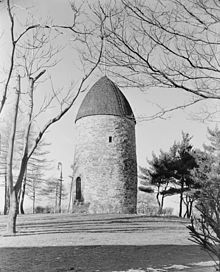| Powder Alarm | |||||||
|---|---|---|---|---|---|---|---|
| Part of the Boston campaign of the American Revolutionary War | |||||||
 The Old Powder House in Somerville, Massachusetts, as it stood in 1935, atop the hill at Nathan Tufts Park overlooking Powder House Square | |||||||
| |||||||
| Belligerents | |||||||
|
|
| ||||||
| Commanders and leaders | |||||||
|
|
| ||||||
| Strength | |||||||
| Disputed | 260 regulars | ||||||
The Massachusetts Powder Alarm was a major popular reaction to the removal of gunpowder from a magazine near Boston by British soldiers under orders from General Thomas Gage, royal governor of the Province of Massachusetts Bay, on September 1, 1774. In response to this action, amid rumors that blood had been shed, alarm spread through the countryside to Connecticut and beyond, and American Patriots sprang into action, fearing that war was at hand. Thousands of militiamen began streaming toward Boston and Cambridge, and mob action forced Loyalists and some government officials to flee to the protection of the British Army.[1] A similar event, also called The Powder Alarm, occurred in Virginia in April, 1775.
Although it proved to be a false alarm, the Powder Alarm caused political and military leaders to proceed more carefully in the days ahead, and essentially provided a "dress rehearsal" for the Battles of Lexington and Concord seven and a half months later. Furthermore, actions on both sides to control weaponry, gunpowder, and other military supplies became more contentious, as the British sought to bring military stores more directly under their control, and the Patriot colonists sought to acquire them for their own use.
- ^ "How a revolt in Somerville helped spark the American Revolution". www.wbur.org. 2024-08-29. Retrieved 2024-09-02.